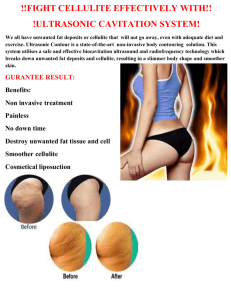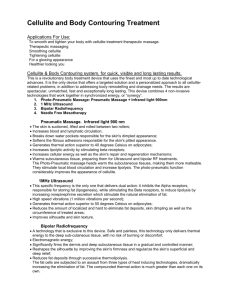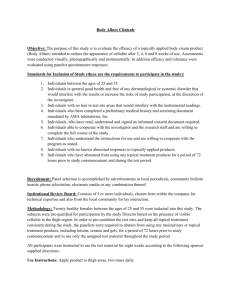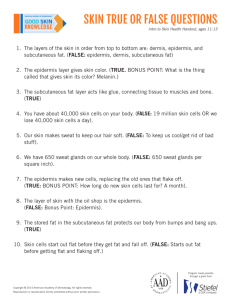What is Cellulite? - Weight No More Diet Center
advertisement
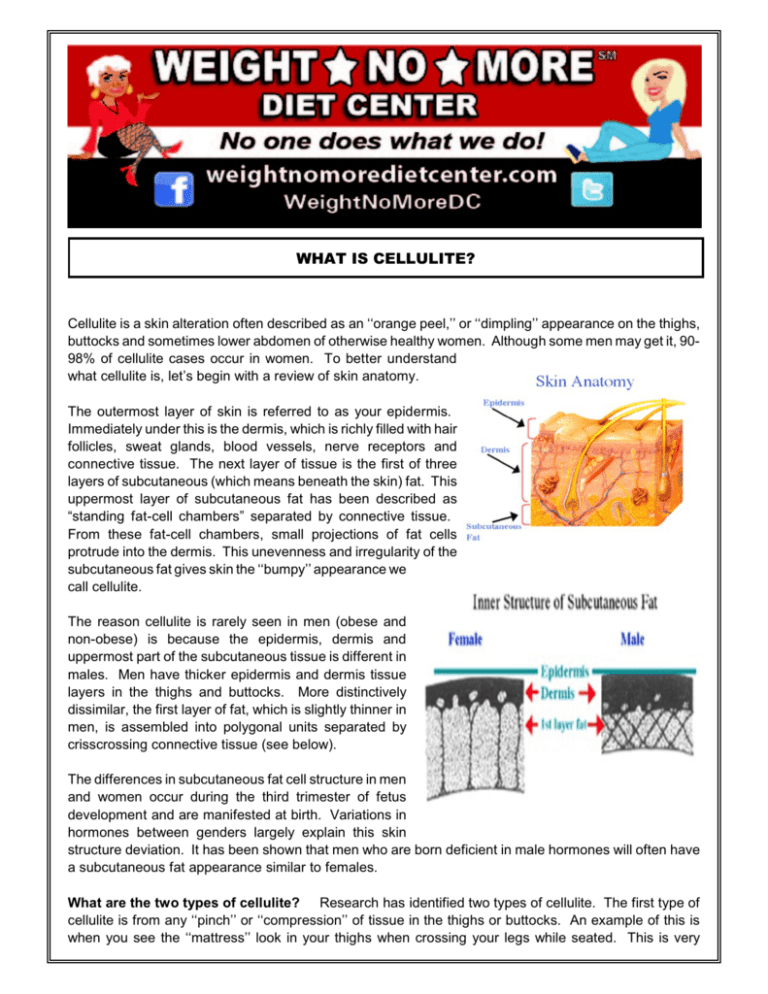
WHAT IS CELLULITE? Cellulite is a skin alteration often described as an ‘‘orange peel,’’ or ‘‘dimpling’’ appearance on the thighs, buttocks and sometimes lower abdomen of otherwise healthy women. Although some men may get it, 9098% of cellulite cases occur in women. To better understand what cellulite is, let’s begin with a review of skin anatomy. The outermost layer of skin is referred to as your epidermis. Immediately under this is the dermis, which is richly filled with hair follicles, sweat glands, blood vessels, nerve receptors and connective tissue. The next layer of tissue is the first of three layers of subcutaneous (which means beneath the skin) fat. This uppermost layer of subcutaneous fat has been described as “standing fat-cell chambers” separated by connective tissue. From these fat-cell chambers, small projections of fat cells protrude into the dermis. This unevenness and irregularity of the subcutaneous fat gives skin the ‘‘bumpy’’ appearance we call cellulite. The reason cellulite is rarely seen in men (obese and non-obese) is because the epidermis, dermis and uppermost part of the subcutaneous tissue is different in males. Men have thicker epidermis and dermis tissue layers in the thighs and buttocks. More distinctively dissimilar, the first layer of fat, which is slightly thinner in men, is assembled into polygonal units separated by crisscrossing connective tissue (see below). The differences in subcutaneous fat cell structure in men and women occur during the third trimester of fetus development and are manifested at birth. Variations in hormones between genders largely explain this skin structure deviation. It has been shown that men who are born deficient in male hormones will often have a subcutaneous fat appearance similar to females. What are the two types of cellulite? Research has identified two types of cellulite. The first type of cellulite is from any ‘‘pinch’’ or ‘‘compression’’ of tissue in the thighs or buttocks. An example of this is when you see the ‘‘mattress’’ look in your thighs when crossing your legs while seated. This is very gender-typical to almost all women of various ages, and is suggested to be the compression of the fat-cell chambers underlying the skin. The second type of cellulite is the ‘‘mattress’’ or ‘‘orange peel’’ appearance that a woman may have in her natural stance or when lying down, which is referred to as cellulite. What is the connective tissue in the dermis? The connective tissue in the dermis provides the framework, insulation and stability of the dermis layer below the epidermis. It offers a necessary insulation and stability between the various organelles, permitting their proficient function, without inhibition to adjacent structures. It’s composed primarily of collagen, an inelastic tissue with great tensile strength, ground substance, and elastic tissue, which gives the skin it’s ability to extend and return to normal constituency. Do you have to be overweight to have cellulite? Since cellulite is largely due to a structural conformation below the skin, it is often common in very slender women. However, individuals who are over-fat will frequently have a more pronounced cellulite development, while those with less fat and more muscular definition tend to have less visible cellulite. Why does cellulite tend to get worse as you age? In women, the dermis reaches its maximal thickness at 30 years of age. Secondly, the dermis area, which is bound together by the connective tissue starts to get looser, due to the aging process of the collagen and elastic fibers. This allows for more adipose cells to protrude into the dermis area, accentuating the sight of cellulite. In addition, an increased deposition of subcutaneous body fat may often reflect a lifestyle of less exercise and changes in dietary consumption. Why is cellulite more prevalent in the thighs and buttocks? It is well established that women generally have a higher percentage of body fat than men. For instance, a healthy range of body fat for women is 20-25%, and a healthy range of body fat for men is 10-15%. The thighs and buttocks of women tend to store more of this body fat. This type of fat deposition is characteristically termed gynoid, or pear shape. Body fat is stored largely due to the actions of an enzyme know as lipoprotein lipase (LPL), located on the blood vessel walls throughout the body. It functions like a ‘‘regulatory’’ enzyme, which controls the distribution of fat in various depots in the body. It has been shown that women have a higher LPL concentration and activity in the hip and thigh region. Why does cellulite affect some people more than others? There is much variation in anatomy and skin anatomy from person to person. Women have unequal amounts of subcutaneous fat, as well as variable thickness and denseness of the dermis and epidermis skin layers. Why do women who lose a lot of weight still have cellulite? The underlying fat-cell chambers do not change with a loss of weight. For optimal skin adaptation to weight loss, it is advisable for weight loss to be progressive and not extreme (such as repeatedly seen with fad diets). Also, skin elasticity is best up to the age of 35 to 40 years. Collagen and elastic fibers can retract best to lesser volumes (from fat loss) before this chronological age. Will liposuction surgery help reduce cellulite? Quite the contrary! Liposuction is not very successful in treating cellulite and may actually worsen the dimpled skin appearance. What are some realistic recommendations? Several studies note that female athletes, who generally have a lower percent body fat regularly have less cellulite. So, a caloric-restricted diet plan to help reduce some of the underlying body fat should be implemented. Aerobic exercise at least 3 to 5 times a week for at least 20 to 60 minutes will help create a satisfactory caloric deficit. Perhaps most essential to your exercise agenda is your resistance exercise program. The subcutaneous fat rests on top of muscle, and if the muscle is weak and flaccid, this can contribute to the ‘‘bumpy’’ effect of cellulite. Although there isn’t one best system of sets and repetitions to firm all of your leg muscles, regularly include the following exercises in your resistance training program. Squats and leg press for buttocks and thigh muscles. Hip adduction exercises for inner and outer thighs. All types of lunges for the thighs and buttocks. Leg curls for the back of the thighs. Summary It is clear that the cause of cellulite is much more sophisticated than just saying it is extra fat underneath the skin. It is noteworthy to appreciate the fact that cellulite is a unique and distinctive layer of subcutaneous body fat that is common to females. Incorporating a caloric restrictive diet with aerobic exercise and resistance training has the most promising and realistic results. _________________ Facebook - Twitter ____________________________________________________________________________________________________ WeightiNoiMoreK Diet Center provides the above for general information purposes only. Patients should always consult with their physicians for diagnoses and specific dietary protocols.
